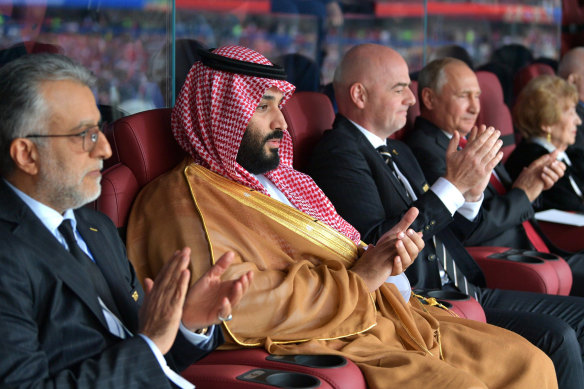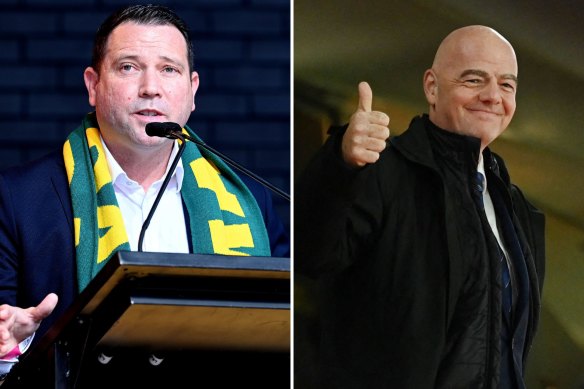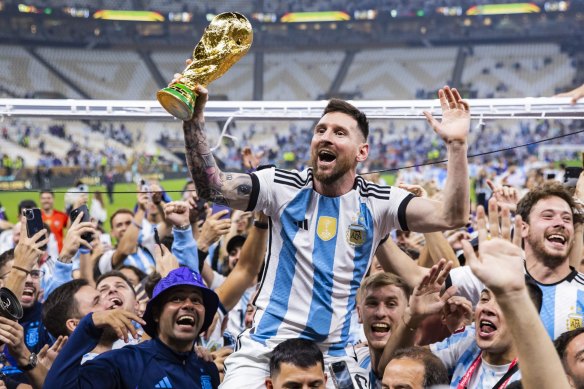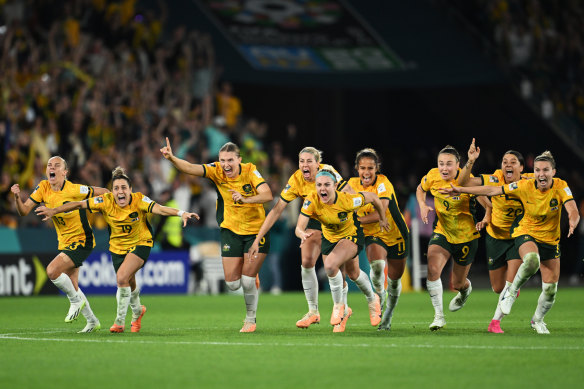- Analysis
- Sport
- Soccer
- FIFA World Cup
This was published 1 year ago
What are Australia’s chances of hosting the 2034 FIFA World Cup?
By Emma Kemp
This is how the timeline went.
In the early hours of October 5, FIFA announced – out of the blue and a year before the deadline – that the 2030 men’s World Cup would be jointly hosted by six countries across three continents.
At the same time, president Gianni Infantino – also out of the blue and ahead of schedule – invited countries from the Asia and Oceania regions to submit bids for the 2034 tournament and gave them 25 days to decide.
Minutes later, the Saudi Arabian Football Federation’s LinkedIn page pinged with a ready-made statement confirming it would bid.
Minutes after that, the Asian Football Confederation president, Shaikh Salman bin Ibrahim Al Khalifa of Bahrain, said Saudi Arabia had Asia’s united backing.
Over the next few hours support streamed in from Frenchman Karim Benzema (Al-Ittihad’s new star), Italian Roberto Mancini (Saudi Arabia’s new national team coach), Englishman Steven Gerrard (Al-Ettifaq’s new manager) and his new player (and fellow Englishman) Jordan Henderson.
So we are just leaving all of that there, without comment or conspiracy theory.
Perhaps in the same way that FIFA announced the above without even holding a press conference to answer questions from the world about why it had completely changed the hosting format for 2030 without warning, and concurrently fast-tracked the 2034 bidding process, also without warning.
The lack of a press conference is a good way to slot fellow 2034 bid hopefuls Australia into this puzzle. And if that is an appropriate analogy, then Australia is but one in a 211-piece FIFA member associations-themed puzzle, on a strategic mission to find its groove among the rest, even though about half have already been connected into a Saudi-shaped bloc before the bids are even in.

Saudi Arabia’s Crown Prince Mohammed Bin Salman Al Saud with FIFA president Gianni Infantino in 2018.Credit: Getty Images
But back to the press conference. In 2010, the last time Australia bid for the men’s tournament, there were very big press conferences at a very big auditorium in Zurich.
The extravaganza involved then FIFA president Sepp Blatter, who gloated that football would “go to new lands” after announcing Russia and Qatar as the 2018 and 2022 hosts respectively.
They also involved Vladimir Putin, who invoked the spirit of World War II, saying Russians had played football even in (what it calls) the Great Patriotic War and during the 900-day Siege of Leningrad.
And they involved Sheikh Hamad bin Khalifa Al-Thani, then Emir of Qatar, who was eager to “present a new image of the Middle East far away from cliches and closer to reality”.
Australia received only a single vote for their 2022 bid, which cost $46 million in taxpayer money, and was eliminated in the first round of voting.

Football Australia chief executive James Johnson used to work closely with FIFA president Gianni Infantino.Credit: Getty
A bitterly disappointed Football Federation Australia chief executive Ben Buckley said afterwards: “We were confident that we had stronger numbers than that.”
Several years later, Blatter told Australian FIFA whistleblower, Bonita Mersiades, that “Australia had no chance. Not a chance. Never.”
Books have been written about that particular bid process, and Mersiades herself has written one on Australia’s conduct throughout that time.
Internationally, it ended with an early morning 2015 raid by Swiss police and corruption charges against senior FIFA officials.
Within Australia, it prompted an unwritten but indefinite moratorium on World Cup bids. The federal government wouldn’t go anywhere near it after such an unmitigated disaster. The Garcia Report of 2014 found “significant evidence” that Australia had tried to influence voting through improper payments.
FIFA has since reformed its bidding process – requirements for 2026 and beyond, demand due diligence on existing human rights conditions, and bidding countries must submit a human rights strategy as part of their preparations for and hosting the 48-team tournament.
But while gifts of cash in brown paper bags may be a thing of the past, cash in general is not – and Saudi Arabia has poured billions of dollars into its dizzying futuristic alternate reality. The Saudis call it “Vision 2030 – a thriving economy where everyone has the opportunity to succeed”. Quite a few others call it “sportswashing”.
And, it has been impossible to miss, the oil-rich conservative Gulf monarchy has swiftly achieved a prominent role in world sports. The acquisition of English Premier League club Newcastle United, a Formula One race, LIV Golf, a merger with the PGA Tour. Cristiano Ronaldo, Neymar, Riyad Mahrez, Benzema, Mancini, Gerrard. Henderson.
These players and managers, on contracts worth hundreds of millions of dollars per season, now tweet in Arabic. In September, Henderson “wrote” what translates as: “The Kingdom of Saudi Arabia, the generous hosting, the enthusiasm of the fans, the enjoyable league and the irreplaceable feeling of winning”.
He followed it with a sentence in English more befitting a long-time Liverpool midfielder who grew up in Sunderland: “Great win, looking forward to meeting up with the [England] lads now”.
Meanwhile, the English language skills of France forward Benzema have seemingly improved exponentially since his move to the Saudi Pro League. “Wow! Amazing news,” he tweeted about the Saudi 2034 bid announcement. “The future is bright - congrats to all my friends and fans in Saudi Arabia on this big announcement. I know how much you love the game and what this would mean to you! It would be an incredible FIFA World Cup.”

Lionel Messi after winning the World Cup in Qatar in December.Credit: Getty Images
While this has all been playing out, Australia – together with New Zealand – has hosted the 2023 Women’s World Cup to unprecedented success. Football Australia and its chief executive, James Johnson, have restored the government’s faith in the domestic game’s governing body, and are also viewed in a positive light from Switzerland. Johnson himself holds an especially favourable place in Infantino’s heart, having worked closely under him as FIFA’s head of professional football between 2015 and 2018.
Even before this year’s Women’s World Cup began, Johnson had flagged to this masthead that hosting the 2034 World Cup (and the expanded 2029 Club World Cup) was on the agenda. He reaffirmed that intention repeatedly throughout the tournament, but his comment on the record was less categorical.
“As stated previously, Football Australia is exploring the possibility of bidding for the 2029 FIFA Club World Cup and/or the FIFA World Cup 2034,” he said on October 5.
“We acknowledge FIFA’s communication regarding the FIFA World Cup 2034, and we are encouraged that after the hugely successful FIFA World Cup Qatar 2022 and FIFA Women’s World Cup Australia and New Zealand 2023, the football family of Asia and Oceania will once again have the opportunity to showcase their ability to welcome the world and host the best FIFA tournaments.”
But Australia’s brand of soft power does not extend to supporting all of Infantino’s ever-expanding mind map of pet projects. And the petro-plutocrats have scratched the new regime’s back diligently. This is their reward. It may sound a bit like jumping to conclusions. There are, unfortunately, few other feasible conclusions to be drawn.

The Matildas celebrating Cortnee Vine’s match-winning penalty against France during the 2023 Women’s World Cup.Credit: Getty
Infantino is also operating FIFA’s continental rotation policy, which stipulates that each confederation must take turns in hosting. By utilising the reintroduced joint-bid concept to award 2030 to the joint bid of Morocco, Portugal and Spain, and then adding World Cup centenary games in Uruguay, Argentina and Paraguay, FIFA has managed to tick off three confederations in one hit: Africa, Europe and South America.
The sheer distance between these places makes this four-week “unique global footprint” of extensive air travel an interesting method of achieving FIFA’s aim to be net-zero by 2040. But it is a novel way of ensuring the Confederation of African Football (CAF), the Union of European Football Associations (UEFA) and the South American Football Confederation (CONMEBOL) are not allowed to throw their hat in the ring for 2034.
With the Confederation of North, Central America and Caribbean Association Football (CONCACAF) also ruled out because Canada, Mexico and the United States are hosting in 2026, that leaves the Oceania Football Confederation (OFC) and the Asian Football Confederation (AFC) as the only eligible pools of candidates.
The biggest fish in Oceania is New Zealand which, even in a joint bid with other Pacific nations, does not have the infrastructure for a 48-team tournament. This leaves Asia, and Saudi Arabia – the outstanding, and currently only, candidate.
Counter-bids have until October 31 to make themselves known. Given Saudi has been sewing up support from Asian member federations one by one through its Saudi Vision 2030 projects, Australia is having enough trouble tying down a joint-bidder.
A case in point was the Indonesia backflip. On October 11, Erick Thohir, the chairman of the Football Association of Indonesia, said officials had been in talks with Australian counterparts about a joint bid that could also include Malaysia and Singapore.
Exactly one week after that public revelation, Thohir released a statement declaring South-East Asia’s largest country now stood with Saudi Arabia. The October 18 U-turn came hours before an AFC Extraordinary Congress meeting, during which Infantino implored AFC members to “be united in Asia for the 2034 World Cup”.
“Which again will unite the world,” Infantino said via video link from Zurich. “As we see, there is enough division already all over the world. We have occasion to bring people together. We have occasions to bring unity … you have a responsibility in this respect. You play an important role in this unity.”
Johnson has gone quiet these past few weeks, as diplomacy undoubtedly heightens until deadline day. It is believed Football Australia has not ruled out bidding for the 2029 Club World Cup and the 2034 World Cup. It is most definitely bidding for the 2026 Women’s Asian Cup.
Ambition – even at this late stage – is no bad thing because ambition can generate leverage. And look what happened with Saudi Arabia: it had its sights set on hosting 2030; now FIFA has positioned it perfectly to host 2034.
News, results and expert analysis from the weekend of sport sent every Monday. Sign up for our Sport newsletter.